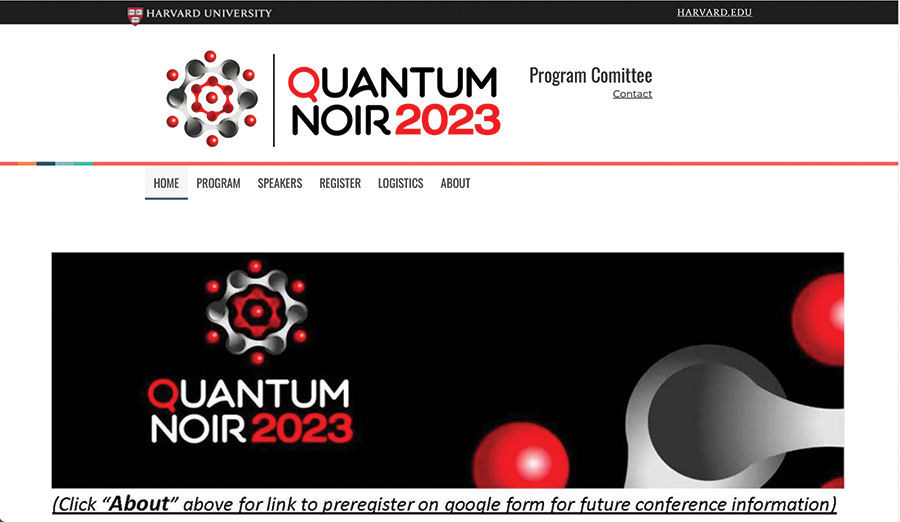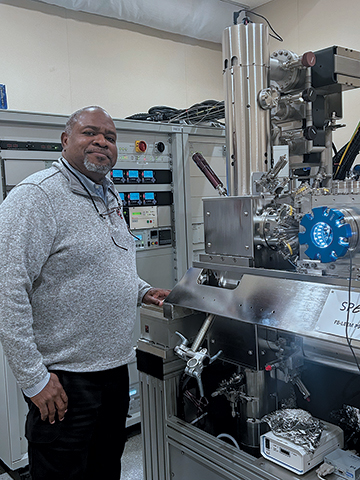
Bill Wilson [Image: Courtesy of W.L. Wilson]
Editor’s note: In a May 2023 feature article, “Breaking Barriers, Advancing Optics,” Optics & Photonics News profiled six Black scientists in the United States, their pathbreaking work in optics, photonics and related areas, and their perspectives on progress and challenges for underrepresented groups in science. In this special accompanying online “Conversations” series, we offer edited versions of the interviews behind those profiles.
In this installment, OPN chats with William L. Wilson, the executive director of the Center for Nanoscale Systems (CNS) at Harvard University, USA.
What initially got you interested in science?
Bill Wilson: I would say from the time I came out of the womb, I’ve always been completely captured by how stuff works. I started taking stuff apart as soon as I could figure out how to use a screwdriver. And my grandmother, who passed away many years ago, once said she decided that I was bright when I was about four years old and I fixed a toaster. She didn’t know that I probably broke the toaster in the first place. [Laughs]
That was kind of my M.O. as a kid—taking stuff apart, figuring out how stuff works. I used to joke at my older sister that I couldn’t understand how she could watch a television and not care how it worked.
Your Ph.D. was in physical chemistry. What led you from there to optics?
I kind of fell into chemistry because I liked solving chemistry problems. And we didn’t have a whole lot of physics classes in schools in Philadelphia when I was growing up. I mean, I went to a pretty good high school—Central High School. But I don’t think our physics class was very good. I thought the chemistry class was more interesting.
And I loved math, particularly geometry. Just the idea that you could prove stuff—I just thought that was the most insane thing ever. I could make logical arguments that gave me the absolute truth. At that time, applied math kind of seemed wacky to me. And physics just didn’t seem interesting. So, I just kind of fell into chemistry.
When I graduated from high school, though, I had no money. So I decided to go work to save enough money for school. So I went to New York, and I tore down buildings for a year and a half. That’s how I raised money for my first few years of college. I used to joke that, I paid for my first year of tuition in cash in person, and that made me the most serious student known to man.
Then I went to Saint Joseph’s University in Philadelphia for an undergraduate degree in chemistry. But still, I was a gadget person. Soon I found another gadget person My chemistry professor, John Berberian, who did low-temperature dielectric measurements, and I started working for him. I got into doing all kinds of crazy experiments, and I realized I wanted to do experimental physics. As I started to do more and more experimental work, I got interested in doing laser spectroscopy.
I did two internships at Bell Labs. First I worked for a chemical engineer Henry Law, and the second year, I worked for Gary Patterson, doing dynamic light scattering in his lab. He was my first mentor for the Bell Labs Cooperative Research Fellowship Program.
Anything notable from your internship at Bell Labs?
That Summer I really got interested in nonlinear spectroscopy and just weird materials in general, you know, quantum wells, quantum wires, quantum dots. I was actually at Bell Laboratories the summer Louis Brus discovered quantum dots in the lab next to mine.
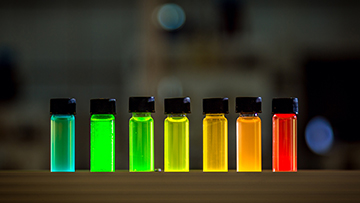
Louis Brus discovered the colloidal semi-conductor nanocrystals known as quantum dots, which emit different colors depending on size. [Image: T. Ruzgar/Getty Images]
I tell this story to students all the time. Louis wasn’t trying to make quantum-confined semiconductor particles. He was interested in doing surface-enhanced Raman scattering. He wanted to make semiconductor colloids to hang dye molecules off of so that he could do Raman. And he ended up with semiconductor colloids that had spectra that were the wrong color. And that’s how the whole quantum-size effect got started. Because he was trying to do something else.
How did you decide to go to Stanford for your Ph.D.?
I did my graduate work at Stanford because, my first summer at Bell Laboratories, in the dorms on the Rutgers University Busch campus where they housed all of the summer students, I sat down with two guys who were doing graduate work in physics at Stanford. And they were telling me, “Hey, you should think about coming to Stanford.” I had never considered the possibility of ever going to California. I was a kid from Philadelphia. I was going to stay close to home, maybe go to Princeton or Cornell. Then I thought, “Well, if nothing else, I should at least take a trip out there and see what it looks like.” That’s how I ended up going to Stanford, which was absolutely the right choice.
At Stanford, I thought I would do light scattering. Then I met people doing ultrafast spectroscopy, like Michael Fayer, a professor in the chemistry department, and I was hooked. To be totally honest, my approach to my career has always been more or less a random walk—it’s a random walk of stuff that I get interested in.
I often joked that I was the only graduate student in Fayer’s group at Stanford who had done every nonlinear technique in the lab at least once. I mean, it was true when I was a graduate student. Fayer’s lab offered various techniques—time-resolved luminescence, light scattering, transient grating measurements, four-wave mixing measurements and so on. And I did a little bit of everything. I did CARS [coherent anti-Stokes Raman spectroscopy], CSRS [coherent Stokes Raman spectroscopy], low-temperature time-resolved luminescence measurements, photon echoes—things like that.
Because I like building gadgets, I built three laser systems while I was there. And then I would always want to do some wacky experiment. I would always get measurements that, most of the time, didn’t make any sense. And I got to the point where I would joke that the reason why my measurements don’t make sense is because I actually don’t believe quantum mechanics.
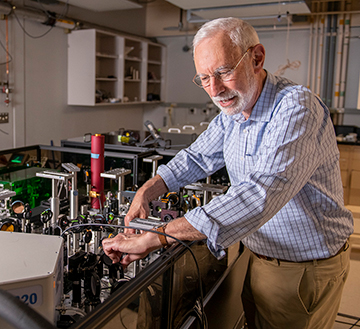
Bill Wilson's Ph.D. advisor, Michael Fayer, working in a lab. [Image: L.A. Cicero / Stanford University]
You don’t believe quantum mechanics? There has to be a story there.
Yes. So, some of us in the lab came up with this wacky idea one night over beers, where we were going to use transient gratings to measure the dynamics of gas species in flames. The idea was, we would set up a transient grating, we would excite atomic species in the flame, and then we would watch the grating dissipate as a way of looking at the species migration. Then we thought, why don’t we start with a sodium cell, just to make sure this whole transient grating thing works.
If you actually do the experiment, you get a beautiful Maxwell-Boltzmann curve of the way the grating decays. But before we got to that part, one of the guys said, “You know, if you put sodium cells in a magnetic field, you get these weird splittings in sodium. We can steal a magnet from the lab next door. Let’s try that.” So we stuck the magnet on our setup, and we got all these huge oscillations on sodium’s curves. And we were like, “What the hell is that?” It turns out, of course, you get a quantum beats driven by the hyperfine splitting. Again, like I said, I would have expected it if I actually believed quantum mechanics.
That was one of the last things that I did in graduate school. I took apart an old atomic absorption spectrometer, mounted the burner head on my laser table and had this thing set up for the flame experiment. And then as I was looking at it, I thought to myself, “Why am I doing this? I’m five years in. I’m going to go home, write my thesis and get out of here.” And that’s what I did.
I don’t think anybody actually did the crazy flame experiment. But that was the experiment that told me it was time for me to leave.
After your Ph.D., you spent about 13 years at Bell Labs working on a huge range of things: quantum dots, ultrafast lasers and even optical networks. Can you talk about your experience there?
My interest in going to Bell Labs was to do the same kinds of experiments that I did at Stanford, but on more interesting materials systems—quantum dots, quantum wells, things like that. When I got there, I started collaborating with Louis [Brus] because he was interested in doing time-resolved experiments on quantum dots. So that’s where I got started. I built up a system to do time-correlated single-photon counting.
And then Moungi Bawendi, who’s now a professor at MIT, came in first as a summer student and then later as a postdoc for Louis. We worked together on characterizing quantum dots with time-resolved and steady-state spectroscopies. Then I moved on to semiconducting polymers. Tim Weidman was making silicon backbone polymers at the time. Spectroscopically, those materials looked a little bit like quantum-confined amorphous silicon. So we characterized those systems.
Then you co-founded InPhase Technologies. How did that start?
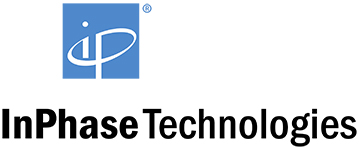
InPhase Technologies logo. [Image: InPhase Technologies Inc. / Wikimedia Commons]
I was having lunch one afternoon, and there was a heated argument about holographic data storage. I knew a little bit about it because when I left Stanford, IBM tried to hire me to work in its holographic data storage group. I had gone through the literature and thought, “This is just nonsense.”
But then I got talked into giving a presentation at Bell Labs about the status of holographic data storage. So I went through the updated literature and decided that the holographic data storage field hadn’t advanced very far, but the technologies around it had grown up. For example, the necessary lasers and modulators existed. The CMOS active-pixel sensors were fast enough to be used as detectors. These didn’t exist when I was in graduate school.
So if someone wanted to try developing a system, there were enough parts around. But there wasn’t a material that was fitting. So with a small group at Bell Labs, I started working on materials and technologies for holographic data storage.
How did you make the decision to start a new company and leave a well-established place like Bell Labs, especially when you didn’t quite believe in the technology?
When it comes to the holographic data storage technology, I’m still a skeptic. I will always be a skeptic. Because I’ve actually built a system and know how hard it is
The story of how InPhase got started isn’t a typical startup story. As we began our effort at Bell Labs, I was talking with Demetri Psaltis one day, and he told me that he had this great student, Kevin Curtis. So I hired him as a postdoc to kind of get into the holographic data storage field because I knew a lot from surveying literature, but I hadn’t really built anything. Ever since, Kevin and I have been great friends. He’s a sensational scientist. We used to joke all the time that we were separated at birth, because we thought about things the same way. Kevin and I bootstrapped the effort at Bell Labs, both on the material and the system sides, walking through holographic storage phase space.
At the same time, Lucent [Bell Labs’ parent company] was splitting up and trying to figure out how to redefine itself. One of the things Lucent did was to create a new venture arm as part of it. I think we [InPhase Technologies] may have been the second or the third company that was created as a part of that. So we began as a startup, but we weren’t independent of Bell Labs. Initially, Bell Labs owned about 20% of the company.
And, originally, I wasn’t necessarily going to join the startup. I mean, everybody else was gung ho about going in, and I was a little bit older and my family was more established. I was like, “I don’t necessarily think I need to do this.” But then, I sat on a call one evening, and I was basically told that if I didn’t go, there might not be a company. Then I had two thoughts: I didn’t want to let down the folks who I worked with, and I also wanted to see the technology get finished. I felt like the technology was one of my kids. So I decided to go ahead and do it.
So what did InPhase Technologies achieve?
We actually built the first drive— a RAM disk, holographically recorded—with 300 GB of storage on a 5.25-inch disk, which would be completely unimpressive now. But we walked the path of developing the media, building the systems, and, like I said, building the first drive. I used to have the first drive in my office.
Did you face any challenges as a company founder who’s Black?
I don’t know if there were any real challenges that were associated with my being Black. But to be totally honest, I’ve ignored that stuff since I was seven. I mean, I’ve had all kinds of weird interactions in my career, especially when scientists meet me for the first time. They would read a lot about work I’ve done, but they wouldn’t know that I’m Black. For many it came as quite a surprise.
For example, the first time I got invited to an APS meeting, the guy who was the chairman of the meeting kept introducing me as a Black scientist. He kept saying I was a Black scientist before he said my name, when it was obvious that I’m a Black scientist. I think it was because he was shocked. I walked in, and he figured I was supposed to flip on a projector or something. So I had that kind of interactions off and on.
“I tell folks all the time, my personal view is that racism is not my problem. It’s your problem, and it’s not my job to fix your problem.”
But frankly, I don’t take any of that stuff personally. I just don’t have time. I don’t have the bandwidth to waste with that. I tell folks all the time, my personal view is that racism is not my problem. It’s your problem, and it’s not my job to fix your problem. So if you can’t deal with me because I’m a Black scientist, I don’t really need to deal with you. I can make my way without you, you know? You’re not that important to my science.
How did you transition from InPhase, to academia?
That’s also kind of a funny story. I was at an MRS Meeting, and I was sitting in a corner, looking through the bulletin. Then, Howard Katz—an old Bell Labs collaborator of mine, who was a department chair at Johns Hopkins—walked up to me and said, “Hi, Bill. You look miserable. You should come to Hopkins.” After the meeting, I went back to my office in Colorado and started thinking. I thought, I’ve been commuting a lot between Colorado and New Jersey because my family was in New Jersey. Also, that was right after the [market] crash in 2008, and my investors were at war with each other. So I was like, “I’m just tired of this nonsense.” Howard and Jim West, another former Bell Labs colleague at Hopkins, lobbied me a bit more and I decided it was time.
So I boxed up my stuff, got in my car, came back to the East Coast and went to Hopkins. I was very interested in doing spectroscopy again, but I wanted to do spectroscopy and microscopy on small structures—single-molecule spectroscopy and stuff like that. At Hopkins, I was asked to help support the Integrated Imaging Center. Michael McCaffery, the director, wanted to evolve the facility so that it wouldn’t just be for biology, but also support materials studies. That’s how I got into facility-management activities.
Then you moved to Illinois, and then to Harvard.
I had been at Hopkins maybe two or three years when John Rogers came to visit. I knew John since graduate school, and he was at the University of Illinois at Urbana–Champaign at that time. So we were sitting in my office talking, and he said, “You should really think about coming to Illinois. We really need somebody to run the central facilities for MRL [Materials Research Laboratory]. You have a lot of friends in Illinois, you’d fit in really well there because it’s a very collaborative place.” And I said, “Well, I’m pretty cool here at Hopkins. I’m actually teaching nonlinear optics to biologists, which has been really fun.” He then said, “You should just come out anyway and give a talk. You’ll at least get a dinner out of it.” So I went, and they gave me a full-court press on coming out there. That’s how I ended up at Illinois. I was there about three, four years.
When Harvard wanted to restructure how it managed CNS [Center for Nanoscale Systems], a friend of mine asked me to come and talk to the folks about how they should restructure so that it could be run a little more like the way MRL was running. I think MRL was an interesting one because historically, these core labs on a university campus are usually half-managed by a faculty member. Because the faculty members are running their own groups, they just don’t have the bandwidth to think about the facility. So when I went to Illinois, it was the equivalent of having a senior scientist whose job it was to run the facility. But I could also do all the stuff that a faculty person does. I would write proposals and grant applications. So the person who was the “faculty director” suddenly found themselves freed from having to do so much.
I think Harvard looked at that model and thought, “We need somebody like that, who’s not just a lab manager, but somebody who could help drive this place as a dynamic, enabling scientific arm.” That’s basically what I’ve been doing since I’ve been here. I talked to Harvard about how I ran MRL and how to think about the restructuring of CNS. And then I went back to Illinois, and then six months later, people at Harvard asked me to apply for the job.
I actually didn’t apply right away because I really liked Illinois. I ended up coming back to the East Coast, in part because my family is here. All my kids are here, all my grandkids are here and our parents are still here.
Do you get a chance to get into the lab and do experiments yourself in this position at Harvard?
Not anymore. At Illinois, I could do it. In fact, at Illinois, I used to have a small research group. But I can’t do that here. I just don’t have the bandwidth, and it wouldn’t be fair to students. I do have a postdoc, though. I used to get a little bit of work done in the lab because I’m interested in doing nearfield spectroscopy. But now, I hardly get to go into the lab. I live vicariously through my postdoc.
But Harvard has given me an opportunity to help other scientists of color, letting me be in a position to make a case for the kinds of programs that people need. So CNS is the New England hub for NNCI [US National Nanotechnology Coordinated Infrastructure]. One of the programs we created is called CNS scholars. Through the program, we allow scientists from minority institutions, underserved institutions and small schools to come to Harvard to do work in our labs for free. Well, I shouldn’t say it’s free—the NSF [US National Science Foundation] pays for it.
“One of the real issues scientists of color face is that they get isolated where they are. They don’t get connected to communities where they can do new, good and interesting work.”
We run CNS scholars in a really collaborative way. The idea here is to get people connected and create a community. One of the real issues scientists of color face is that they get isolated where they are. They don’t get connected to communities where they can do new, good and interesting work. And it’s not that people are shunning them or anything. It’s just harder to integrate yourself and get connected, especially if you don’t start in a place that requires you to be collaborative.
I went to a small liberal arts college in Philadelphia. And I was really the only student of color in the hard sciences at the start. There were a couple of us later, but they were biology students who are doing pre-med. So I always felt a little bit isolated. And I also felt a little bit like a unicorn while I was there. CNS scholars is really an effort to prevent this by connecting folks to the community.
Forming a collaborative community certainly seems important.
As you know, I started my career at Bell Labs, and it was the most important influence on my career. You couldn’t function at Bell Labs unless you were collaborative. They only hired collaborative people. You couldn’t be productive hiding in your own lab, trying to work with only a technician. It just didn’t work. So you learned how to operate in a collaborative culture, but not all cultures start that way.
Companies like Bell Labs, IBM, Exxon and Xerox don’t really have summer programs anymore. When I was an undergraduate, I went and worked summers at Bell Laboratories, and I got all my instrumental experimental training. A lot of my peers at the time also got their training from working at big companies. Bell Laboratories used to have 1,100 kids on their campus every summer, and many of those students were from historically Black colleges. And that’s how they got introduced to experimental science. The first summer I went to Bell Labs, I was just enamored with the fact that there were other folks who looked like me who cared about science as much as I did. That’s when I decided that I was going to work there.
That doesn’t exist anymore. With the loss of the programs that industry had, like Bell Labs, there’s a sense of community that’s gone. If you go to a typical historically Black college and look at what their faculty in physics are doing scientifically, they’re all doing RF work or they’re doing astronomy because it’s easier to get an internship at NASA than it is at Intel.
With those programs gone, how can scientists of color create a community?
I’m organizing a conference called Quantum Noir, which is going to be a quantum/nano conference for folks of color plus—meaning folks of color, people from other underrepresented groups and allies. We were hoping to do it this summer, but it’s looking like, with the timing of the funding, we may have to defer it until the summer of 2024.
Quantum Noir is going to be a quantum and nanoscience meeting for researchers of color, people from other underrepresented groups and allies, offered every two years. [Image: projects.iq.harvard.edu/quantumnoir2023] [Enlarge image]
There are few condensed-matter scientists of color because we’re not training young African American physicists in historically Black colleges to do condensed-matter work. I’ve been talking a little bit with Kayla Lee of the IBM-HBCU Quantum Center about its activities. And one of the real issues is, every year, the program has a lot of experimental stuff that they’re funding. But all students do is theoretical work because nobody’s making devices. None of these institutions have that kind of infrastructure. It is possible for them to do device-related work at CNS or other university fabs for free, but the faculty and students don’t know that those opportunities exist.
So one of the reasons for creating Quantum Noir is to help create and connect a condensed-matter community. I’m basically copying something that’s already been going on for many, many years—probably 30 or 35 years old. A colleague of mine from Bell Laboratories, Bill Massey, a professor at Princeton University, created a meeting called CAARMS, the Conference for African American Researchers in the Mathematical Sciences. And it’s a two- or three-day conference in the early part of the summer. And it succeeded in creating a really cohesive African American mathematics community.
I’ve gone to this meeting many times because Bill is a friend of mine. And I always said there should be a condensed-matter version of the same meeting. There needs to be a small meeting for community building, where people can teach tutorials and just talk about the science that they’re doing.
I started thinking late last summer, we really need to do this. I wrote a proposal to the NSF that went out in November. I don’t think there’s enough time for the first meeting to be held this June. So we’re going to do is spend a year advertising and do one in June of next year. The NSF is going to fund two cycles, so we’ll do one in June 2024 and then one in June 2026. And hopefully, do it every two years after that.
Early in your career, you won an award for mentoring. Could you speak about your experience both as a mentee and a mentor and the role that mentorship plays for people in traditionally underrepresented communities in STEM?
I’ve always had ensembles of people that I could ask questions. That’s kind of what you want. You want somebody that you can feel comfortable asking dumb questions. As a mentor, I’ve always let people know, “You can come ask me your dumb questions, and I won’t judge you.”
There are a lot of unwritten rules that people just don’t know. Like, when I talk to young scientists about writing proposals, I say, you’ve got to put yourself in the shoes of the program manager. The program manager is trying to build a portfolio of projects that will impress his boss. To that extent, if you can help him do that, he will fund you.
Looking at your career, your work has been interdisciplinary. Have you always enjoyed interdisciplinary work?
I always joked that Mother Nature doesn’t care about disciplines. It’s all the same to her. So I’ve always walked the random walk of interesting science. When I was at Bell Laboratories I didn’t have the most patents among the members of technical staff, but I had the most varied patent portfolio. Because I would sit at a lunch meeting and get into a conversation and say, “Oh, that’s cool. I can help you do this.” I still do that quite a bit. I just get enamored with ideas periodically, and I feel the need to go down that rabbit hole.

